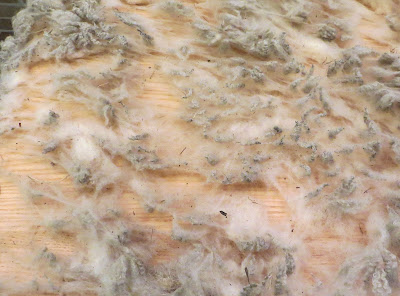The challenge - to do this in less than a week.
I contacted my friends and bribed them with promises of food and the chance to play with my English Wool Combs and on Sunday 28 August 2011 they came to the house for the day, complete with aprons. I had initially thought that we'd be removing the thickest of the hair and kemp, along with a bit of skirting, so I sold them on the fun of a De-Hairing Party. (Spinners are robust people. Spinning wheels have parts called mother-of-all, maiden, orifice, lazy-kate, so calling an event a De-Hairing party was guaranteed to get people involved)
How wrong I was!
We started off with moving the bags of fleece to one side of the lounge and putting a white sheet on the carpet. The intention was for Carol and I to empty one bag at a time onto the sheet, pick out the nice bits of fleece, and carry them to the table in the sunny kitchen where the de-hairers, Sue, Ros & Alison were ready with their smiles.
But then we found the felted bits of fleece, the 'rough as a badger's arse' kempy, hairy britch bits, the thistles, grass, hay........ and the pooh. We had a lot of fleece to get through. Here's a small selection.
We did however keep finding little sections with the superfine undercoat. It just seemed such a shame to include this with the rest of the fleece to be swallowed up in the final yarn. There was so little that taking it out of the Boreray yarn fleece wouldn't affect the character and softness of the yarn. The decision was made to separate it out.
So now we're all happy again. Very happy indeed, because the only thing we could think of to do with this superfine undercoat was to hand-spin it. So we could all share it out and have fun spinning it. There was talk of making some of our hand-spun yarn available for knitters, fundraising for Borerays and RBST.... We thought of a lot of things, but mostly we thought about the joy of hand-spinning some incredible laceweight Boreray yarn.
We cracked on with sorting out the fibre for NFC and got that done before the end of the day. Just time to start de-hairing the fine undercoat we'd kept separate.
Now it's really difficult to photograph very fine fibre, unless you're someone like Deb Robson. You can see her super photographs of Boreray on p156 of the Fleece & Fiber Sourcebook This is my attempt to show some of the Boreray fibre.
On the left against the red background is a lock of hair fibre that has been eased from a lock of fleece. Top on the right is what's left. The dark coloured fibres are kemp. Borerays have white and coloured kemp. The vertical dark line is the 'rise'. This is the natural break between the fleece from the old year and the new fleece. There are some scurfy skin cells along the rise and you can see that the new year's growth has more kemp than the old fleece that has been sheared or cut off the sheep.
The bottom right hand image is a close up of part of the image above it. The slightly creamy coloured 'cloud' is the fine undercoat. Too fine to even see the individual fibres. It's easier to identify it by feel - just imagine what the finest undercoat on a mouse might feel like, and you're in the right area.
So that was how we finished a day we'll never forget. Sitting there with woolsacks full of the very characterful Boreray fleece in colours ranging from white to dark brown and prepared all ready for the Natural Fibre Company. Most importantly we were over the 20kg. And just time to sit round the table and start de-hairing the fine undercoat.
 A few days later I took the Boreray fibre with me to British Wool
Weekend and at the end of a tiring but most enjoyable weekend, Sue
Blacker had the job of fitting it all into her car to take down to
Cornwall. We'd also found time over the weekend to talk about the few
kg of fine Boreray and another plan was hatched.
A few days later I took the Boreray fibre with me to British Wool
Weekend and at the end of a tiring but most enjoyable weekend, Sue
Blacker had the job of fitting it all into her car to take down to
Cornwall. We'd also found time over the weekend to talk about the few
kg of fine Boreray and another plan was hatched. 























